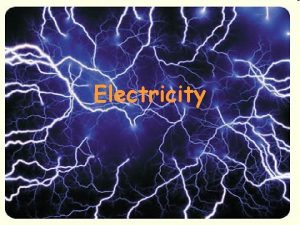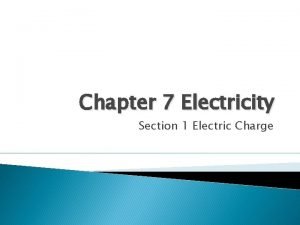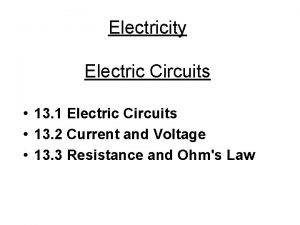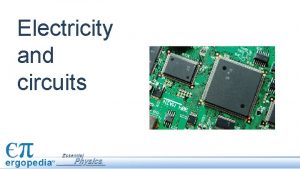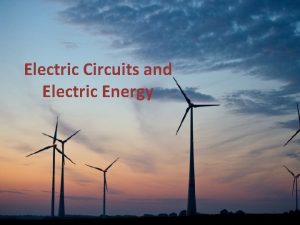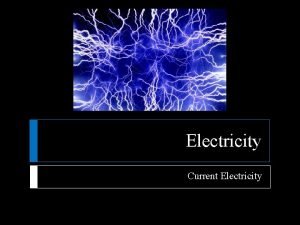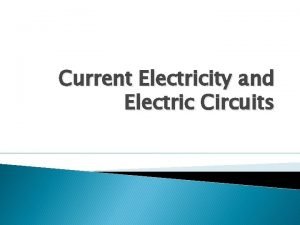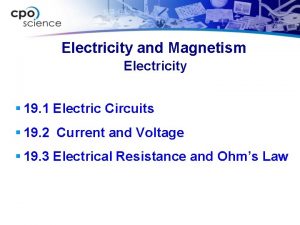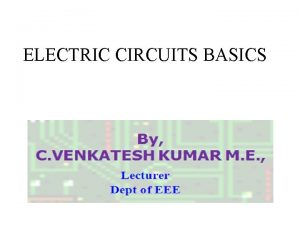Electric Circuits Electricity and Electric Circuits Electric energy










- Slides: 10

Electric Circuits

Electricity and Electric Circuits Electric energy is always transferred by the movement of electric charge. The movement or flow of electric charges from one place to another is called electric current. When a current is passing through a controlled path is called an electric circuit.

Parts of an Electric Circuit • All electric circuits have the same four basic parts: • 1) A source of electrical energy – could be a battery, a wall outlet, a portable generator, etc. • 2) Electrical Load – Converts electrical energy into the form of energy we need. This is actually the reason the circuit exists. A toaster, a lightbulb, a microwave, are all electric loads. • 3) Electric Circuit Control Device – Turns the circuit on or off – think light switch or power button. • 4) Connectors – They provide the path for the electric current to flow to each part of the circuit (wires).

Circuit Diagrams

Electric Current • An electric current is made up off moving electric charges. • Electric current is a measure of the rate at which electric charges move past a given point in a circuit. • The unit used to measure electric current is the Ampere. (It’s symbol is A)

Electrical Resistance • All materials resist the flow of electrons to some extent. • This ability to impede the flow of electrons is called resistance. • The symbol for electrical resistance is R and the unit is the ohm (Ω).

Ohm’s Law • Ohm’s Law tells us that V = I x R • Where: • V = voltage • I = Current (measured in amperes) • R = resistance (measured in ohms (Ω))

Sample Problem 1 • What is the voltage drop across the tungsten filament in a 100 W light bulb? The resistance of the filament is 144 Ω and a current of 0. 833 A is flowing through it. • Step 1: List variables: • V=? • I = 0. 833 A • R = 144 Ω • Step 2: Substitute values into the formula • V=I x R • V = 0. 833 x 144 • V = 120 Volts

Sample Problem 2 • An electric toaster is connected to a 120 V outlet in the kitchen. If the heating element in the toaster has a resistance of 14 Ω, calculate the current flowing through it: V = 120 V I=? R = 14 Ω V=Ix. R 120 = I x 14 I = 120/14 I = 8. 6 A

Sample Problem 3 • The current required to operate an electric can opener is 1. 5 A. What is the resistance if the supply voltage is 120 V? V = 120 V I = 1. 5 A R=? V = IR 120 = 1. 5 x R R = 120/1. 5 R = 80 Ω
 Static electricity and current electricity
Static electricity and current electricity Electricity n
Electricity n Magnetism vocabulary
Magnetism vocabulary Advantages of parallel circuit over series circuit
Advantages of parallel circuit over series circuit Potential energy of capacitor
Potential energy of capacitor Energy energy transfer and general energy analysis
Energy energy transfer and general energy analysis Energy energy transfer and general energy analysis
Energy energy transfer and general energy analysis Chapter 6 electricity section 1 electric charge answers
Chapter 6 electricity section 1 electric charge answers Section 1 electric charge crossword puzzle answers
Section 1 electric charge crossword puzzle answers Electricity section 1 electric charge
Electricity section 1 electric charge Electric circuits by james nilsson and susan riedel
Electric circuits by james nilsson and susan riedel








